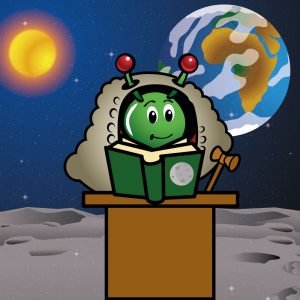Energia z wody - Jak produkować tlen i wodór na Księżycu
W tym zestawie trzech ćwiczeń uczniowie poznają zagadnienia związane z elektrochemią.
Na pierwszych zajęciach zbudują stos woltaiczny - prostą baterię. Wynalazek ten dał początek elektrochemii.
Następnie uczniowie będą badać elektrolizę. Elektroliza wykorzystuje prąd elektryczny do rozdzielenia wody na jej składniki: wodór i tlen. Produkty te mogą być wykorzystane jako materiały pędne dla statków kosmicznych i/lub do dostarczenia tlenu dla załogi.
W ostatnim ćwiczeniu uczniowie badają i wykorzystują ogniwo paliwowe.
Cele nauczania
Zakres wiekowy:
14 - 16 lat
Czas
Przygotowanie: 1 godz.
Lekcja: 2 godziny
Lekcja: 2 godziny
Zasób dostępny w:
Zadanie 1: Zbuduj swoją własną baterię
W tym ćwiczeniu uczniowie skonstruują stos woltaiczny - prostą baterię - z metalowych płytek, ściereczki do naczyń i octu. Stos woltaiczny wykorzystuje spontaniczną reakcję chemiczną do wytworzenia energii elektrycznej.

Sprzęt
Ćwiczenie 2: Elektroliza
W tym ćwiczeniu uczniowie zbudują elektrolizer: urządzenie, które wprowadza prąd elektryczny do cieczy za pomocą dwóch elektrod. Użyją urządzenia do elektrolizy wody i odkryją, że możliwe jest rozdzielenie wody na jej składniki: tlen i wodór.

Sprzęt
Ćwiczenie 3: Ogniwo paliwowe
W tym ćwiczeniu uczniowie wykorzystają produkty elektrolizy wody (H2 i O2) w ogniwie paliwowym. Zbadają, jak ogniwa paliwowe wytwarzają energię elektryczną i ciepło w wyniku reakcji chemicznej. Studenci rozważą możliwości i ograniczenia ogniw paliwowych w eksploracji Księżyca.
Sprzęt
Wiedziałeś?
Elektroliza wody jest główną metodą generowania tlenu na pokładzie Międzynarodowej Stacji Kosmicznej (ISS). Woda jest zbierana z moczu, ścieków i kondensacji i rozszczepiana na tlen i wodór w Systemie Generowania Tlenu (OGS).
Źródłem zasilania stacji są baterie słoneczne wielkości boiska piłkarskiego. Podobny system mógłby zostać wykorzystany na Księżycu.
Źródłem zasilania stacji są baterie słoneczne wielkości boiska piłkarskiego. Podobny system mógłby zostać wykorzystany na Księżycu.

ISS krąży wokół Ziemi

Księżycowa Konstytucja - Jak zorganizowana byłaby przyszła księżycowa społeczność?
Krótki opis: W tym materiale uczniowie omówią niektóre organizacyjne i społeczne cechy przyszłego osiedla na Księżycu i odniosą je do swoich

Misja na Księżycu - Zaprogramuj kolegę z klasy, aby wykonał misję na Księżycu
Krótki opis: To ćwiczenie wprowadzi uczniów do logicznego myślenia poprzez zaplanowanie, przetestowanie i wykonanie prostej misji na Księżycu. Uczniowie będą pracować w

Bioniczna ręka - Budowa bionicznej ręki
Krótki opis: W tym ćwiczeniu uczniowie zbudują bioniczną rękę z kartonu, sznurków, słomek i gumek. Będą odnosić się do bionicznej



